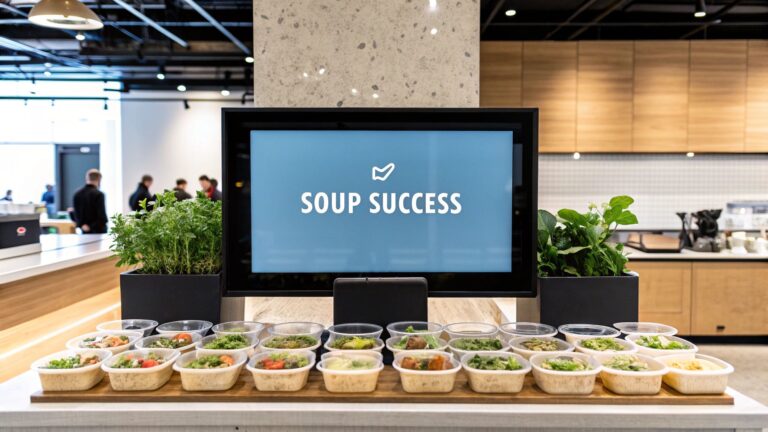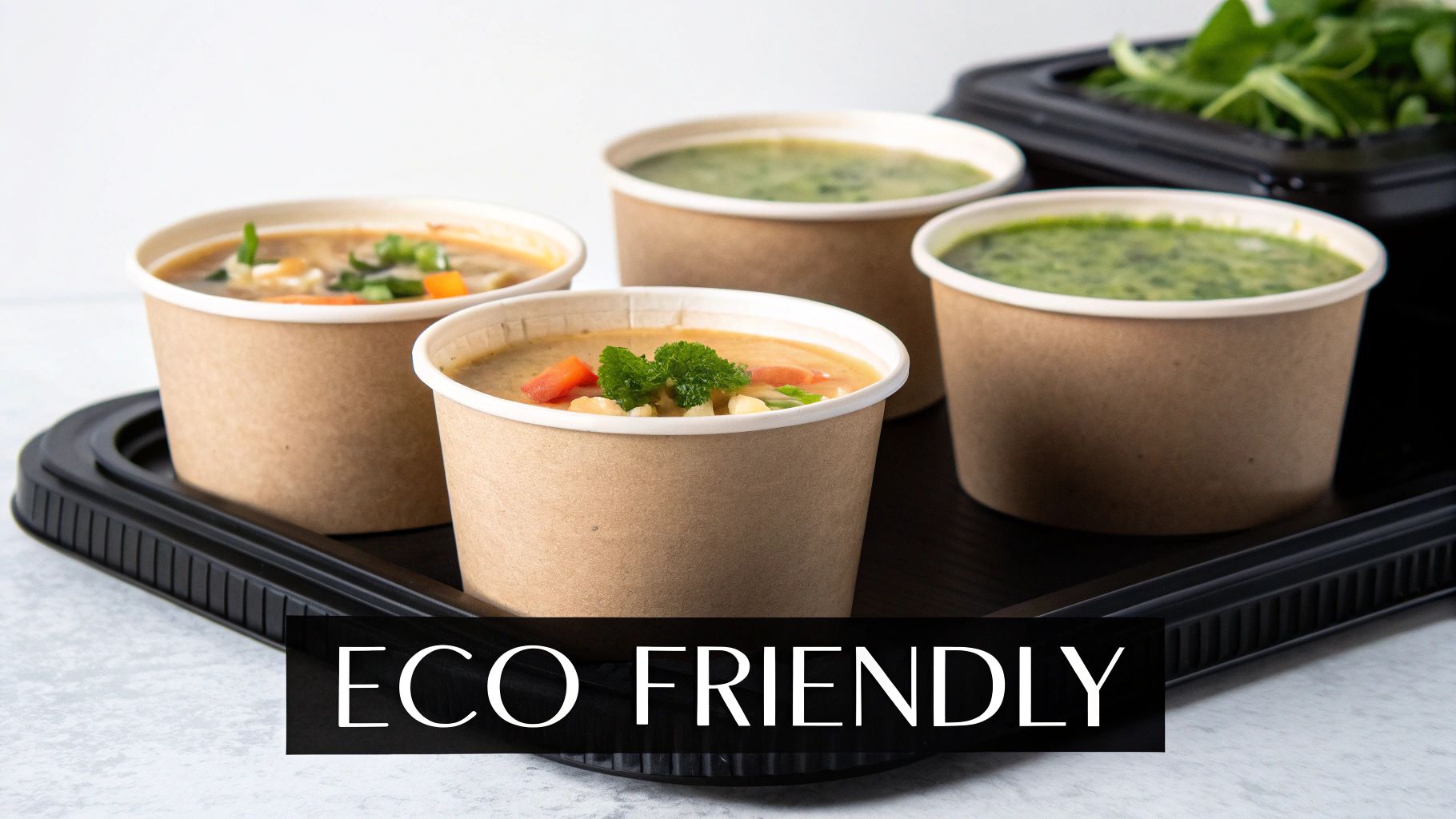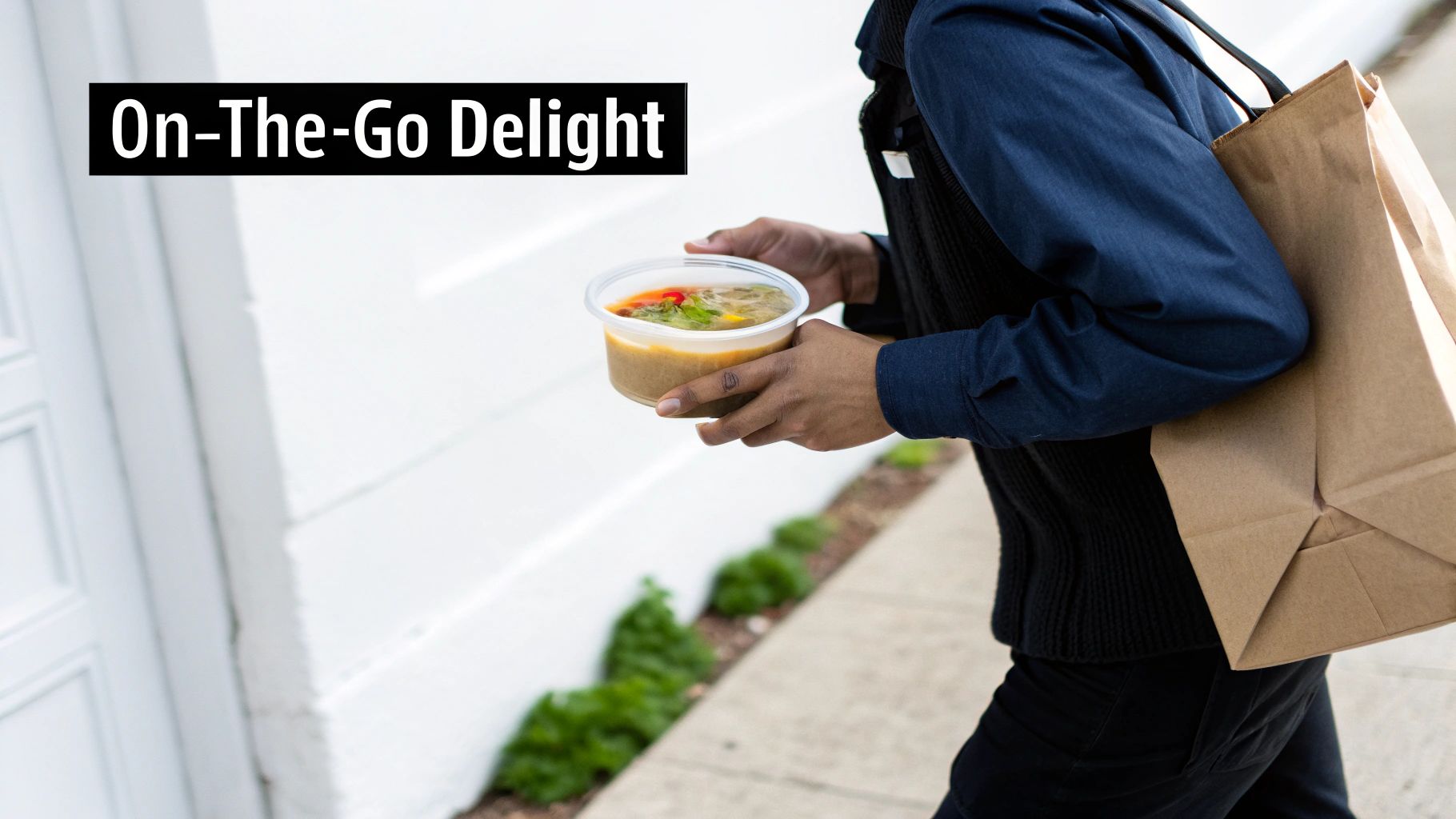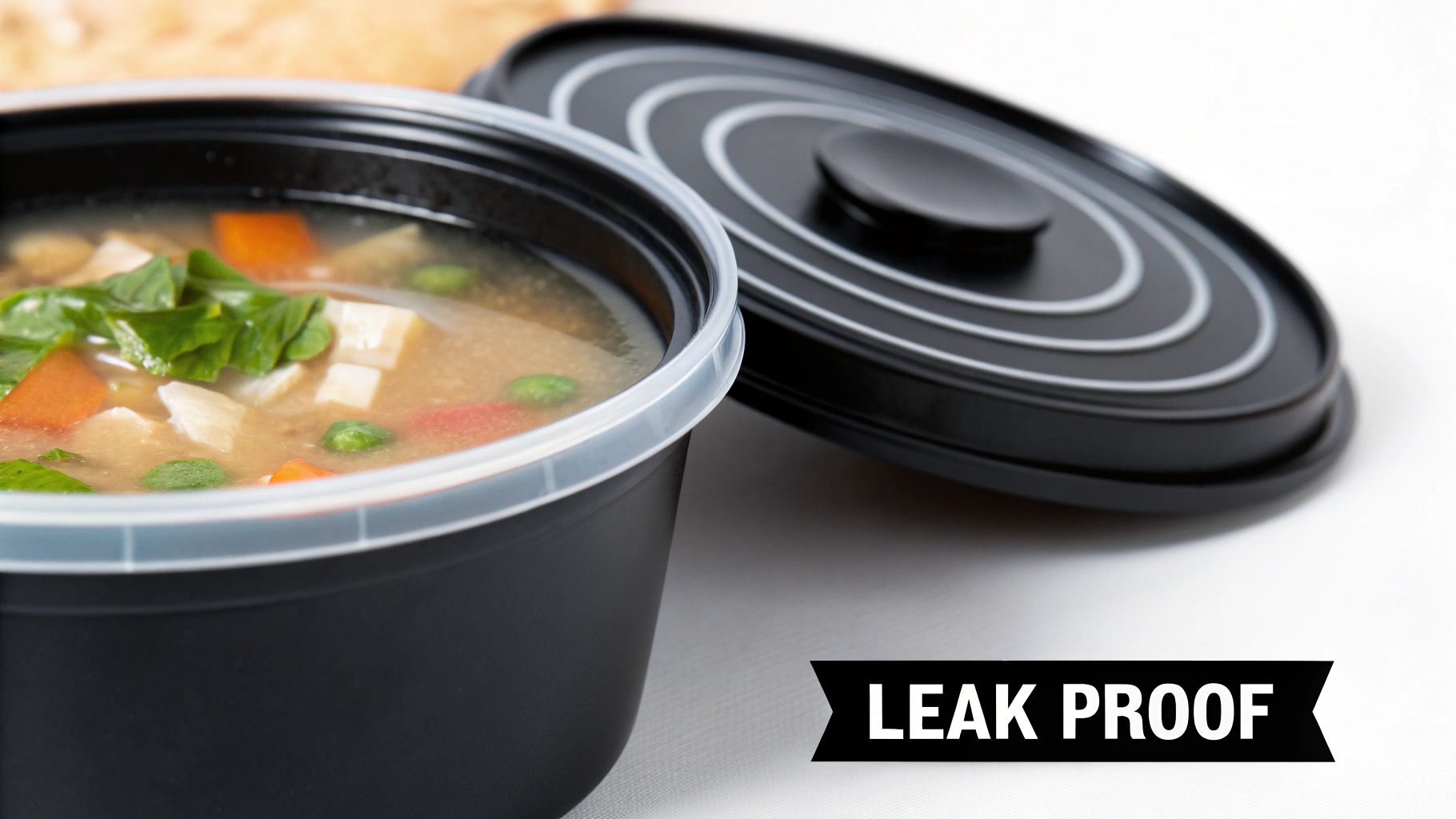The Hidden Impact of Soup Takeout Containers on Success
Soup takeout containers are more than just vessels for your delicious broth; they are a key ingredient in a restaurant’s recipe for success. Often overlooked, these humble containers wield significant influence over customer satisfaction, repeat business, and ultimately, profitability. A leaky container, for example, can quickly turn a positive dining experience into a negative one, impacting your reputation and bottom line.
Customer Perception and Brand Loyalty
The quality of your soup takeout containers speaks volumes about your brand and the care you put into your product. A sturdy, high-quality container signals to customers that you value their experience and the quality of your food. A well-designed container can even elevate the perceived value of the soup itself.
This positive perception contributes to increased customer satisfaction and fosters loyalty. Consider the impact of the unboxing experience. A thoughtfully chosen container, perhaps with an attractive design or a branded sticker, can create a memorable moment for the customer, strengthening their connection with your brand.
Practical Considerations: Temperature and Leaks
Beyond aesthetics, practicality reigns supreme. Temperature retention is crucial. Ensuring the soup arrives at the customer’s door piping hot enhances their enjoyment and satisfaction. Equally important are leak-proof containers. These prevent messy spills and maintain the soup’s quality during transport. These seemingly simple features are vital for a positive customer experience. For more information on disposable soup containers, check out this helpful resource: A Souper Time of Year: A Primer on Disposable Soup Containers.
The Real ROI of Quality Soup Takeout Containers
Investing in quality soup takeout containers is a smart business move. While the initial cost may be slightly higher, the long-term benefits far outweigh the expense. Fewer spills and improved temperature control translate to fewer complaints and increased repeat customers.
The enhanced brand perception that comes with premium packaging can also justify higher prices and attract new clientele. The global takeout container market is expected to reach $163 billion by 2034, with North America accounting for 24.3% of the market share. This growth is driven by the increasing popularity of food delivery services and the rising demand for single-serve meals. You can explore more detailed statistics here: Take-Out Container Market. Choosing the right soup takeout containers is essential for remaining competitive in this expanding market.
Material Matters: Choosing the Right Soup Takeout Container
Picking the perfect soup takeout container is a balancing act. You need to consider functionality, what your customer wants, and how much it will cost. The container material plays a huge role in all three. Different materials perform differently when it comes to heat, leaks, and how tough they are. This seemingly small detail can have a big impact on your profits.
Key Material Considerations for Soup Takeout Containers
Here’s what you should think about when choosing your soup container materials:
- Heat Retention: Keeping soup hot during delivery is critical. Lukewarm soup is a recipe for unhappy customers.
- Leak Resistance: A spill-proof container is a must. Leaks make a mess, upset customers, and could damage other items in the delivery bag.
- Durability: The container needs to survive the delivery trip. A flimsy container that breaks easily won’t protect your soup and reflects poorly on your business.
- Eco-Friendliness: More and more customers care about the environment. Sustainable packaging can set your restaurant apart.
- Cost: Quality matters, but so does your bottom line. Finding the right balance between quality and price is crucial.
Exploring Different Container Material Options
Let’s break down the most common soup takeout container materials:
- Plastic (PP): Polypropylene (PP) plastic is a popular option because it’s durable, good at holding in heat, and relatively inexpensive. It’s not the best for the environment, however.
- Bioplastics (PLA): Made from renewable resources like corn starch, bioplastics (PLA) offer a greener alternative to traditional plastics. However, they may not be as heat-resistant as PP.
- Paper-based containers: Coated to prevent leaks, paper-based containers are an eco-friendly choice that’s becoming increasingly popular. They can be less durable than plastic.
- Foam (EPS): Expanded polystyrene (EPS) foam insulates well, but it’s environmentally unfriendly. Many places are banning it altogether.
- Hybrid solutions: These combine different materials to get the best of both worlds, like a paper container with a PLA lining for better heat retention and leak resistance.
To help you make the best choice, we’ve put together a comparison of these common materials:
Soup Takeout Container Materials Comparison: A comprehensive comparison of different container materials based on key factors that matter to restaurant owners and customers
| Material Type | Heat Retention | Leak Resistance | Eco-Friendliness | Cost Per Unit | Customer Preference |
|---|---|---|---|---|---|
| Plastic (PP) | Excellent | Excellent | Low | Low | Moderate |
| Bioplastics (PLA) | Good | Good | High | Moderate | High |
| Paper-based | Fair | Good | Moderate | Moderate | High |
| Foam (EPS) | Excellent | Excellent | Low | Low | Low |
| Hybrid Solutions | Good to Excellent | Good to Excellent | Moderate to High | Moderate to High | Moderate to High |
As you can see, each material has its pros and cons. PP plastic offers the best heat retention and leak resistance at a low cost, but it’s not environmentally friendly. Bioplastics and paper are more sustainable but can be less durable and/or have lower heat retention. Hybrid solutions offer a balance of benefits but come at a higher cost.
Making the Right Material Choice for Your Business
The best material for you depends on your needs. For short deliveries, paper might work. But for longer trips or hotter soups, insulated containers, like PP plastic or hybrid options, are better. Eco-friendly choices, like bioplastics or paper, show customers you care about the planet.
Think about who your customers are and what they like. People ordering healthy soups might prefer eco-friendly packaging. Finally, consider your budget and find a container that gives you the quality you need at a price you can afford. Taking the time to consider these factors will help you find the perfect container to keep your customers happy and your business thriving.
Portion Perfection: Strategic Sizing for Soup Containers
Choosing the right soup takeout container size involves more than just volume. It’s a strategic decision impacting customer perception, operational efficiency, and profit margins. The psychology of portion sizing plays a key role in customer satisfaction.
The Psychology of Portion Size
A smaller, full soup container often creates greater customer satisfaction than a larger, partially filled one. A full container conveys abundance and value, avoiding the perception of a skimpy portion, even if the total volume is the same or slightly less.
Different soup types may require different sizing approaches. A hearty stew suits a smaller, more substantial container, while a lighter broth benefits from a larger container to enhance perceived volume.
Presentation matters. If your soup includes sides like bread or crackers, the container should complement these additions for a balanced and appealing meal.
Sizing Strategies for Different Business Models
Restaurants tailor soup container sizes to their pricing and demographics. A premium soup may be served in a smaller, elegant container to reinforce its high-end image. A family-style restaurant might use larger containers to emphasize value.
The rise of delivery services has impacted sizing strategies. Containers must minimize spills and maintain temperature during transit. This often means smaller sizes for secure fits within delivery bags.
The growing global soup market influences container demand. The market reached $16.12 billion in 2019 and is projected to reach $21 billion by 2027. The increasing demand for sustainable packaging in North America and Europe further highlights the importance of strategic container choices. For more information, check out this Soup Market Analysis.
Finding Your Optimal Soup Container Size
There’s no universal solution for soup container sizing. The ideal size depends on your menu, target audience, and business model. Analyzing your sales data is a good starting point. Consider questions like: Which soup sizes are most popular? What is the average order size?
Conducting small-scale tests with different container sizes is helpful. Gather customer feedback to gauge their satisfaction and refine your strategy. This iterative process helps find the balance between perceived value, operational efficiency, and profitability, maximizing the impact of your soup takeout containers.
Sustainability That Sells: The New Soup Container Standard
Sustainable soup takeout containers are essential for any food business today. Choosing the right eco-friendly packaging involves more than just picking something labeled “green.” This section explores how to select containers that benefit both the planet and your bottom line. Check out this interesting read on the evolution of sustainable takeout packaging: How Sustainable Takeout Packaging Evolved From the Paper Bag.
Identifying Truly Sustainable Options
Greenwashing is a real concern in the packaging industry. It refers to misleading marketing about a product’s environmental impact. Don’t be fooled by buzzwords. Investigate the container’s actual impact. For instance, some “compostable” containers only break down in industrial composting facilities, which may not be available locally.
So, how can you make truly sustainable choices? Here are some key questions to ask:
- What’s the container made of? Seek out materials like plant-based plastics (PLA), recycled paper, or bagasse (sugarcane fiber).
- Is it really compostable or biodegradable? Confirm the specific conditions needed for decomposition and if those conditions exist in your area.
- What’s the container’s lifecycle impact? Think about the resources used for its production, transportation, and eventual disposal.
Balancing Sustainability, Functionality, and Cost
Eco-friendly containers need to be functional, too. A leaky or weak container defeats the purpose, leading to wasted food and unhappy customers. Different soup types have unique packaging needs. A thick stew, for example, requires a sturdier container than a light broth.
Cost also plays a significant role. Sustainable materials are sometimes pricier than traditional options. However, the long-term gains, such as increased customer loyalty and a positive brand image, often outweigh the initial higher cost. Negotiating with suppliers and buying in bulk can help manage expenses.
Sustainable Soup Container Options
The table below outlines various eco-friendly options for your soup containers, highlighting their benefits, drawbacks, and ideal uses.
Sustainable Soup Container Options: A breakdown of eco-friendly container options with their benefits, limitations, and best applications
| Container Type | Material Source | Biodegradability | Heat Performance | Cost Premium | Best Soup Applications |
|---|---|---|---|---|---|
| PLA-lined Paperboard | Plant-based plastic & paper | Compostable in industrial facilities | Good | Moderate | Most soups, ideal for shorter delivery times |
| Bagasse (Sugarcane) | Sugarcane fiber | Compostable in industrial facilities | Good | Moderate | Hearty soups, stews |
| Molded Fiber (Bamboo, Wheat Straw) | Plant fibers | Compostable in industrial facilities | Fair | Moderate to High | Thicker soups, less ideal for long delivery times |
| Recycled PP Plastic | Recycled plastic | Recyclable | Excellent | Low to Moderate | All soups, especially for longer delivery times |
As you can see, each material offers unique properties. While PLA-lined paperboard offers a good balance for many soups, bagasse is particularly well-suited for heartier options. Recycled PP plastic offers excellent heat performance and is cost-effective, making it a strong choice for deliveries.
Communicating Your Sustainable Choices
Leading restaurants understand the marketing power of sustainable packaging. Make sure to clearly communicate your eco-friendly choices. Share this information on your website, menu, and social media platforms. It appeals to environmentally conscious customers and attracts new business. By showcasing your commitment to sustainability, you reinforce your brand’s values and build stronger customer loyalty.
Switching to sustainable soup takeout containers is a wise business decision. By carefully weighing material options, functionality, and customer communication, you can minimize your environmental footprint, boost your brand image, and contribute to a more sustainable world.
Beyond Basics: Essential Features That Elevate Experience
The perfect soup takeout container isn’t just about holding your delicious creation; it’s a key part of the overall customer experience. Smart features can significantly improve customer satisfaction, simplify your operations, and even enhance your brand’s image.
Leak-Proof Lids and Secure Closure Systems
Anyone who has experienced a soup spill during delivery understands the value of a truly leak-proof container. Look for containers with secure lids and strong closure systems to prevent messy accidents and guarantee your soup arrives perfectly. This not only saves you the cost of replacements but also protects your hard-earned reputation.
Some containers even offer tamper-evident seals, adding an extra layer of security and giving customers peace of mind. This is particularly important in today’s world with the rise of third-party delivery services.
Ventilation and Pressure Release Valves
Proper ventilation is crucial for preventing pressure from building up inside the container. This pressure can cause unfortunate spills when opened. Vents or pressure release valves allow steam to escape, maintaining the soup’s temperature and preventing a soggy disappointment.
For instance, some containers have small, strategically placed vents in the lid that regulate pressure without compromising the leak-proof design. This thoughtful feature preserves soup quality and enhances the customer experience.
Stackability and Storage Efficiency
Efficient storage is a must for busy restaurants. Stackable soup takeout containers optimize space and minimize clutter, vital for both in-house storage and during transport, especially for delivery drivers handling multiple orders. A good stacking design also reduces the chance of containers tipping and spilling.
Temperature Retention: From Kitchen to Customer
Keeping your soup at the ideal temperature from your kitchen to the customer’s table is essential. Insulated containers, or those made with materials that retain heat well, are crucial, especially for longer deliveries. Think of it as a high-tech thermos for your soup, ensuring it stays hot until it reaches its destination.
Innovative Features: Enhancing the Takeout Experience
Looking beyond the basics, innovative features can take your soup takeout to the next level. Temperature-responsive ink indicators can show when the soup is at the perfect temperature. Separate compartments for garnishes and toppings keep everything fresh and prevent sogginess during transit.
Some containers are even designed with delivery platforms in mind, ensuring a smooth and efficient experience for both drivers and customers. These seemingly small details can significantly impact customer perception and satisfaction. Ultimately, choosing the right soup takeout container for your operations and your customers contributes to a successful and positive takeout experience.
Turn Soup Containers Into Powerful Marketing Tools
Your soup takeout containers are more than just vessels for your delicious creations. They represent valuable, and often underutilized, marketing space. Instead of plain packaging, imagine containers that reinforce your brand, engage customers, and encourage repeat business. This is surprisingly achievable with strategic customization, even on a budget.
Cost-Effective Branding Solutions for Soup Takeout Containers
Branding your soup packaging doesn’t have to be expensive. There are cost-effective options for every budget and volume:
- Custom Printing: For larger orders, custom-printed containers with your logo, colors, and a unique message create a polished and consistent brand experience.
- Branded Sleeves: Sleeves provide a flexible, cost-effective option, perfect for limited-time promotions or seasonal menus. They’re easy to change and update as needed.
- Stickers and Stamps: A great choice for smaller businesses or those just starting out, stickers and stamps add a touch of branding without breaking the bank. They’re easy to apply and offer plenty of customization options.
- Creative Design Elements: Think about incorporating interactive design elements that encourage social media sharing. This could include fun facts about your ingredients, quirky illustrations, or a call to action to tag your restaurant on Instagram or Facebook. For more ideas, check out this helpful resource: How to Better Market Your Brand with Custom To-Go Containers.
Leveraging Container Design to Communicate Your Brand
Your soup container’s design should communicate your unique selling proposition. Color psychology is an important factor. Warm colors like red and orange can stimulate appetite, while green suggests freshness and healthy choices.
A clear messaging hierarchy is also vital. Your logo and restaurant name should be prominent, while secondary information, such as your tagline or social media handles, can be subtly integrated.
Using QR Codes for Digital Engagement
Adding QR codes to your soup containers is a smart way to drive digital engagement. Link them to your online ordering platform, loyalty program, or social media pages. This seamlessly connects the offline takeout experience with your online presence, boosting customer engagement and encouraging repeat business.
Driving Social Media Engagement Through Container Design
Smart restaurant owners use their takeout containers to increase their social media presence. Eye-catching designs, contests, or calls to action encouraging customers to share photos can generate buzz and expand your reach. This turns your customers into brand ambassadors, promoting your business through user-generated content.
Consider creating a unique hashtag related to your soup offerings or prompting customers to share their soup photos. This not only increases brand visibility but also builds a community around your restaurant.
By transforming your soup takeout containers into mini-billboards, you can reinforce your brand identity, connect with customers on a deeper level, and ultimately, improve your bottom line.
Maximizing ROI: The True Economics of Quality Containers
Investing in the right soup takeout containers isn’t just about spending money; it’s a strategic move that can greatly affect your restaurant’s profitability. Savvy restaurant owners know the real cost of a container goes beyond the initial price. This section explores the economics of quality soup takeout containers and how they influence your bottom line.
The Hidden Costs of Inferior Containers
While cheaper containers might seem attractive at first glance, they often come with hidden costs that can eat into your profits. Consider these potential pitfalls:
- Spills and Leaks: Flimsy containers are more likely to leak, resulting in wasted product, unhappy customers, and potential refunds. These seemingly minor incidents accumulate, impacting your profits and harming your reputation.
- Poor Temperature Retention: Nobody wants lukewarm soup. Delivering it in a thin container leads to dissatisfied customers and negative online reviews, damaging repeat business and your brand image.
- Repackaging Costs: If your original containers are inadequate, you might need to repackage orders. This adds labor costs, delays deliveries, reduces profit margins, and frustrates customers.
- Damage to Brand Reputation: Consistently using subpar containers reflects poorly on your brand, suggesting a lack of attention to detail. In a competitive industry, this can be detrimental to attracting and retaining customers.
Calculating the True Cost of Soup Takeout Containers
Determining the real cost involves looking beyond the per-unit price. You also need to factor in the potential costs of leaks, refunds, bad reviews, and lost customers. A simple cost analysis can often reveal the long-term advantages of investing in quality containers.
For instance, suppose you save $0.05 per container by choosing a cheaper option, but experience a 2% increase in refunds due to leaks. If you sell 1,000 soups per week, that’s a potential loss of $10.40 each week, adding up to $540.80 annually – significantly more than the initial savings.
Strategic Procurement: Optimizing Your Container Budget
Strategic procurement can dramatically lower container costs without compromising quality. Here are some practical strategies:
- Cooperative Purchasing: Teaming up with other restaurants for bulk purchases can secure significant discounts. This is especially helpful for smaller establishments that can’t afford large orders independently.
- Seasonal Buying: Predicting your needs and ordering ahead, especially during slower periods, can result in lower prices and ensure you have enough stock when demand is high.
- Vendor Relationship Development: Building strong relationships with suppliers can lead to better pricing and delivery terms. Open communication and a collaborative approach are often beneficial for both parties.
Optimizing Your Container Budget Based on Your Business Model
Different business models require tailored approaches to container budgeting. A high-volume, quick-service restaurant might prioritize cost-effectiveness, whereas a fine-dining establishment offering delivery might choose premium, eco-friendly options.
Factors to consider:
- Delivery Radius: Longer delivery times require containers with better insulation and leak-proof designs.
- Soup Menu: Your soup offerings influence container choices. Thick stews might need sturdier containers than thinner broths.
- Customer Demographics: Knowing your target audience and their preferences informs your container choices. Eco-conscious customers may appreciate sustainable packaging.
By carefully evaluating these factors and implementing strategic procurement practices, you can optimize your soup takeout container budget without compromising quality or customer satisfaction.
Ready to upgrade your soup takeout with high-quality, cost-effective containers? Explore the selection at MrTakeOutBags.com and find the perfect solution for your restaurant. Their team can offer personalized guidance and help you select the ideal containers to boost your brand and maximize your ROI.







Comments are closed.